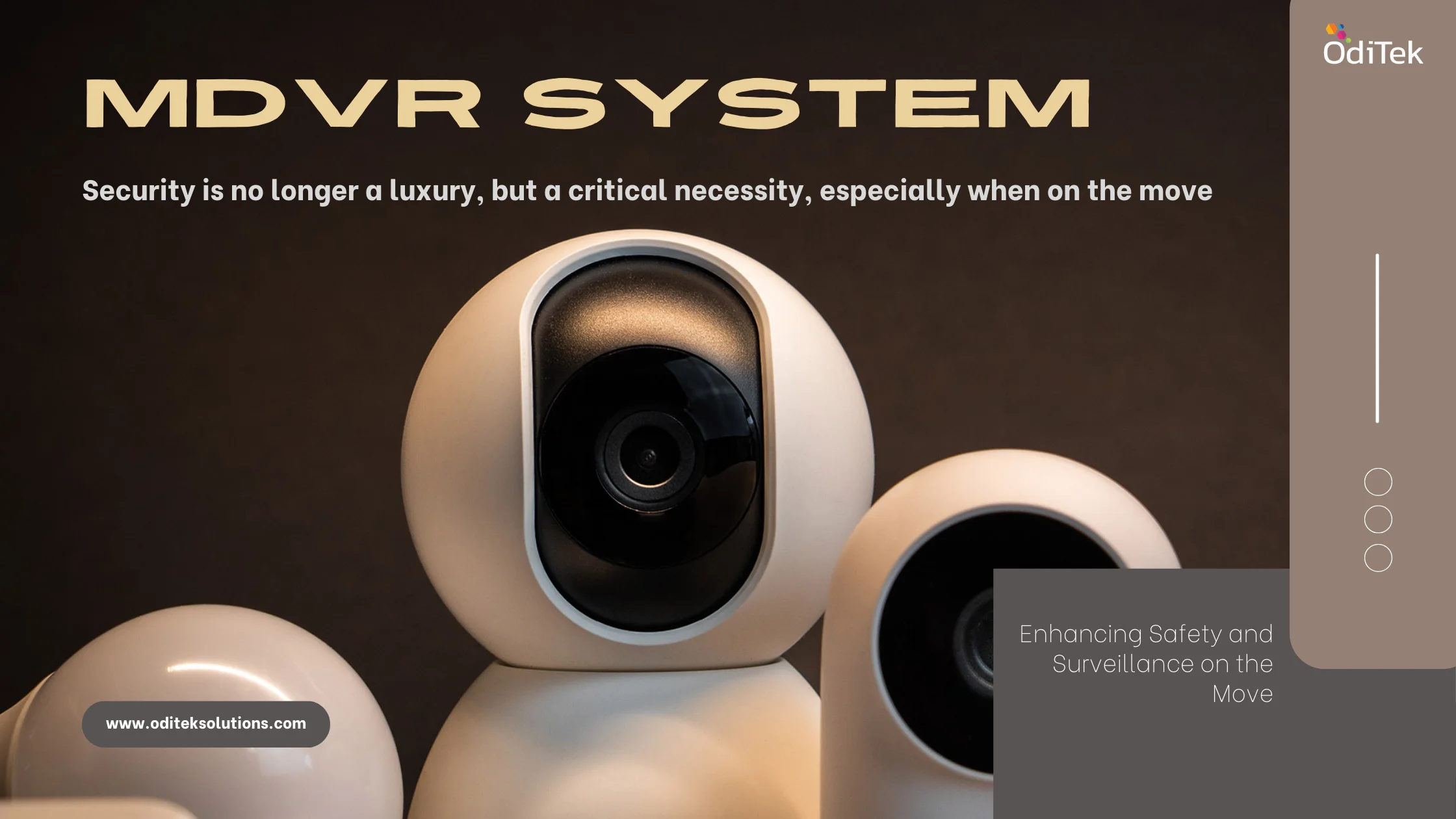Whether it’s public transportation, school buses, commercial fleets, or emergency vehicles—surveillance on the move is essential. That’s where an MDVR System comes into play, providing advanced security and real-time monitoring solutions for vehicles of all kinds. It delivers adaptable, real-time surveillance, supporting a diverse range of vehicular applications.
These systems not only act as a deterrent to potential threats but also provide crucial evidence in the event of incidents, accidents, or disputes. Furthermore, they offer invaluable insights into driver behavior, route optimization, and overall operational efficiency, transforming vehicles into mobile data centers. The ability to remotely access live feeds and recorded footage empowers fleet managers and security personnel to make informed decisions swiftly, ensuring the safety of passengers and assets, and minimizing downtime.
What is an MDVR Camera System?
An MDVR Camera System refers to a Mobile Digital Video Recorder setup that includes cameras, a recording unit, and often GPS and 4G/5G connectivity. Unlike traditional CCTV systems, an MDVR system is specifically designed for mobile environments, making it ideal for use in moving vehicles where vibration, variable lighting, and power fluctuations are common.
At the core of every mobile DVR camera system is the MDVR device—a rugged, compact unit that captures and stores video footage from multiple MDVR cameras placed around the vehicle. These cameras can be positioned on the dashboard, rear, sides, or even inside the cabin to provide a full 360-degree view.
Key Features of an MDVR System
1. Multi-Channel Recording
Most MDVR systems support anywhere from 4 to 8 camera inputs, with some high-end models allowing even more. This enables a full 360-degree surveillance setup around the vehicle—covering the front, rear, sides, and interior. This comprehensive coverage is crucial not only for monitoring driver behavior and passenger safety but also for collecting indisputable evidence in the event of an accident or dispute. Each channel typically supports HD or Full HD resolution for crystal-clear footage.
2. Real-Time Monitoring
Equipped with GPS and 4G/5G connectivity, an MDVR camera system allows real-time live video streaming and location tracking from any connected device. This is especially beneficial for fleet managers who need to keep an eye on multiple vehicles remotely. Real-time monitoring can help detect unauthorized detours, extended stops, or potential emergencies, allowing for faster and more informed decision-making.
3. Remote Access & Alerts
Modern MDVR devices come with intelligent alert systems that notify fleet operators of events like harsh acceleration, sudden braking, lane departures, door openings, or even camera tampering. These alerts can be received via SMS, email, or through a mobile app. Remote access capabilities also allow users to playback footage, adjust settings, and manage storage without having to physically access the device—saving time and improving responsiveness.
4. Durability & Vibration Resistance
Vehicles often operate in challenging environments, including rugged terrains, extreme temperatures, and high-vibration conditions. That’s why mobile DVR camera systems are built with industrial-grade materials and shock-absorbing designs. These systems are typically enclosed in weatherproof and heat-resistant casings, ensuring they function reliably even under the most demanding conditions. This durability is critical for consistent and long-term performance, especially in commercial and off-road vehicles.
5. Data Storage Options
An efficient MDVR system offers flexible data storage configurations, including internal SSD or HDD storage as well as external memory cards and cloud backup. Some systems also feature loop recording, overwriting old footage once the storage is full, while others provide event-based storage—retaining only relevant clips triggered by specific actions or alerts. Cloud connectivity enables instant uploads, reducing the risk of data loss due to theft or device damage. In mission-critical applications, having both local and cloud storage ensures redundancy and peace of mind.
Applications of Mobile DVR Camera Systems
1. Public Transport
Mobile DVR camera systems are increasingly used in buses, trams, and shuttle services to improve safety, security, and service quality. In densely populated cities, monitoring passenger behavior helps prevent vandalism, theft, and altercations, while driver performance monitoring ensures adherence to traffic rules and company protocols. Real-time video and audio recordings also serve as valuable evidence in case of disputes or accidents, improving transparency and accountability.
2. School Buses
For school transportation, student safety is paramount. MDVR systems provide live tracking, allowing parents and school authorities to monitor the bus location in real time. In-cabin cameras help ensure that students are seated safely, not engaging in unsafe behavior, and that boarding and drop-off processes are being followed properly. Video evidence can also be used to investigate bullying or inappropriate conduct, and provide peace of mind to parents.
3. Commercial Fleets
From logistics trucks to delivery vans, commercial fleet operators face constant risk on the road. An MDVR camera system helps reduce liability by capturing high-definition footage of road incidents, collisions, and near misses. This footage is often used for insurance claims, driver training, or legal protection. Additionally, driver behavior analytics—such as monitoring for fatigue, distraction, or aggressive driving—can reduce maintenance costs, fuel consumption, and improve overall fleet efficiency.
4. Emergency Services
Police cars, fire trucks, and ambulances benefit significantly from MDVR devices that support live video feeds and event recording. These systems can document emergency response times, record on-scene activity, and provide vital situational awareness to command centers. For example, live streaming from a firetruck or ambulance can help dispatchers make more informed decisions in real time. Recorded footage also supports post-incident analysis and training for emergency personnel.
Choosing the Right MDVR Camera
Selecting the right MDVR camera or complete MDVR system is crucial to ensuring maximum performance, reliability, and value for your investment. With a variety of options on the market, here are several key factors to consider before making a decision:
1. Camera Resolution and Image Quality
Look for HD (720p) or Full HD (1080p) resolution cameras to ensure clear and detailed footage. High-resolution video is especially important when identifying license plates, faces, or road signs in the case of an incident. Some systems also offer 4K resolution for even greater clarity, although this typically requires larger storage capacity and higher bandwidth for streaming.
2. Night Vision Capabilities
Vehicles operate day and night, so it’s essential to choose MDVR cameras with infrared (IR) night vision or low-light performance. Good night vision ensures consistent visibility in tunnels, dark roads, and unlit areas—reducing blind spots and improving safety during nighttime operations.
3. Storage Capacity and Flexibility
Storage is a critical aspect of any mobile DVR camera system. Depending on your usage, look for systems that support large-capacity SSDs or HDDs, as well as external memory options like SD cards. Some MDVR devices also offer cloud storage integration, which enables footage backup and remote access. Features like loop recording, overwrite protection, and event-triggered recording can help optimize storage use.
4. System Compatibility and Scalability
Ensure that the MDVR camera is compatible with the MDVR device and other system components such as GPS modules, 4G/5G routers, displays, and cloud platforms. Choose systems that are modular and scalable, so you can easily expand or upgrade the setup as your needs grow—whether you’re starting with a few vehicles or scaling up to manage an entire fleet.
5. Build Quality and Environmental Resistance
Since the equipment will be exposed to varying environmental conditions, opt for cameras and MDVR devices that are weatherproof (IP66/IP67 rated), dust-resistant, and capable of withstanding vibrations and temperature fluctuations. Ruggedized systems designed for mobile use will offer better durability and a longer lifespan.
6. Additional Features to Consider
Look for modern features like:
• AI-based driver behavior detection (e.g., fatigue, phone usage, yawning)
• ADAS (Advanced Driver Assistance Systems) integration
• Two-way audio communication for dispatchers and drivers
• Tamper alerts and secure data encryption for protecting sensitive footage
7. Vendor Support and After-Sales Service
Choose a reliable vendor with strong customer support, warranty coverage, and a track record of working with mobile surveillance systems. Access to technical support, firmware updates, and training resources can significantly enhance system performance and usability over time.
Conclusion
A robust MDVR camera system is no longer a luxury—it’s a necessity for any vehicle-based business or service looking to boost security, improve operational efficiency, and ensure passenger and driver safety. Whether you’re managing a single vehicle or an entire fleet, integrating a modern mobile DVR camera system will provide peace of mind and actionable insights on the go.
For more information on this topic or to discuss your specific requirements, feel free to contact us or visit our website. We’re here to assist you and answer any questions you may have.







